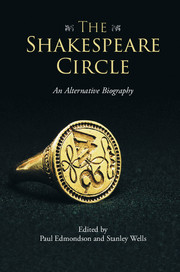Part II - Friends and Neighbours
Published online by Cambridge University Press: 05 November 2015
Summary
In distinguishing people whom we should count among Shakespeare's friends and neighbours, rather than specifically either relatives or professional colleagues, we looked for striking and undeniable evidence of personal connections such as neighbourliness, beneficiaries through legacies (either to or from Shakespeare) and close creative appreciation and engagement.
The Combe family of Stratford-upon-Avon, prominent also in the county affairs of Warwickshire, were close neighbours. Many links are recorded between several family members and Shakespeare at different stages of his life, for example the purchase of land in 1602 and the disputes about the Welcombe enclosures in 1614–15. They lived in the largest house in Stratford, which had originally been established as ‘The College’ for the training of priests close to Holy Trinity Church. Shakespeare's prestigious New Place was second only to The College in terms of size, and only a four-minute walk away. John Combe (whose epitaph has been attributed to Shakespeare) left him £5 in July 1614; Shakespeare bequeathed his sword to the twenty-seven-year-old Thomas Combe, a significant bequest that would surely have gone to Shakespeare's son Hamnet, who would by then have been thirty-one years old had he lived.
A link that takes us from Stratford to London is with Richard Field. He was two-and-a-half years older than Shakespeare and made a career as a distinguished publisher as well as a printer of books in several different languages, reflecting his grammar-school education. Carol Rutter suggestively imagines Shakespeare as ‘Proteus to Field's Valentine’ (p. 163), Shakespeare staying in Stratford to complete his education after his school fellow had left for London. It was Field whom Shakespeare sought out as a printer for his narrative poems, famous for the high quality of their printing, which suggests that Shakespeare himself closely liaised with Field and may even have proof read them in the printing house. Visits to his printing house – a kind of library in its own right – would have enabled Shakespeare to use a number of Field's books when researching his plays. It is worth remembering that, as Chris Laoutoris has explored in his fascinating book Shakespeare and The Countess (2014), Field's printing shop was close to the Blackfriars playhouse in which Shakespeare owned shares and where the King's Men performed from 1609. Indeed, Field was among those who protested against the former monastery becoming a boisterous playhouse.
- Type
- Chapter
- Information
- The Shakespeare CircleAn Alternative Biography, pp. 145 - 148Publisher: Cambridge University PressPrint publication year: 2015



